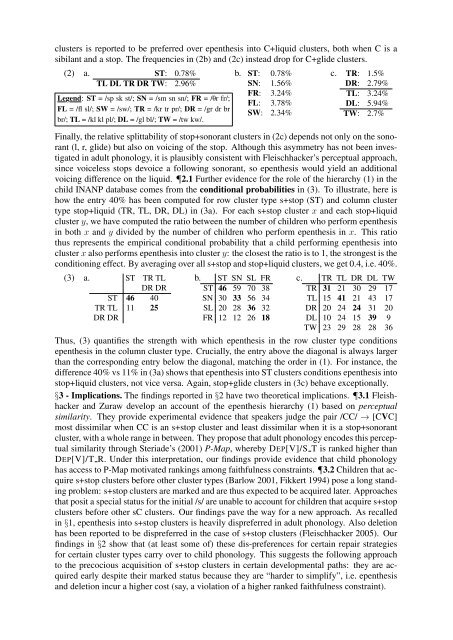Practical Information - Generative Linguistics in the Old World
Practical Information - Generative Linguistics in the Old World
Practical Information - Generative Linguistics in the Old World
Create successful ePaper yourself
Turn your PDF publications into a flip-book with our unique Google optimized e-Paper software.
clusters is reported to be preferred over epen<strong>the</strong>sis <strong>in</strong>to C+liquid clusters, both when C is asibilant and a stop. The frequencies <strong>in</strong> (2b) and (2c) <strong>in</strong>stead drop for C+glide clusters.(2) a. ST: 0.78%TL DL TR DR TW: 2.96%Legend: ST = /sp sk st/; SN = /sm sn sn/; FR = /Tr fr/;FL = /fl sl/; SW = /sw/; TR = /kr tr pr/; DR = /gr dr brbr/; TL = /kl kl pl/; DL = /gl bl/; TW = /tw kw/.b. ST: 0.78%SN: 1.56%FR: 3.24%FL: 3.78%SW: 2.34%c. TR: 1.5%DR: 2.79%TL: 3.24%DL: 5.94%TW: 2.7%F<strong>in</strong>ally, <strong>the</strong> relative splittability of stop+sonorant clusters <strong>in</strong> (2c) depends not only on <strong>the</strong> sonorant(l, r, glide) but also on voic<strong>in</strong>g of <strong>the</strong> stop. Although this asymmetry has not been <strong>in</strong>vestigated<strong>in</strong> adult phonology, it is plausibly consistent with Fleischhacker’s perceptual approach,s<strong>in</strong>ce voiceless stops devoice a follow<strong>in</strong>g sonorant, so epen<strong>the</strong>sis would yield an additionalvoic<strong>in</strong>g difference on <strong>the</strong> liquid. 2.1 Fur<strong>the</strong>r evidence for <strong>the</strong> role of <strong>the</strong> hierarchy (1) <strong>in</strong> <strong>the</strong>child INANP database comes from <strong>the</strong> conditional probabilities <strong>in</strong> (3). To illustrate, here ishow <strong>the</strong> entry 40% has been computed for row cluster type s+stop (ST) and column clustertype stop+liquid (TR, TL, DR, DL) <strong>in</strong> (3a). For each s+stop cluster x and each stop+liquidcluster y, we have computed <strong>the</strong> ratio between <strong>the</strong> number of children who perform epen<strong>the</strong>sis<strong>in</strong> both x and y divided by <strong>the</strong> number of children who perform epen<strong>the</strong>sis <strong>in</strong> x. This ratiothus represents <strong>the</strong> empirical conditional probability that a child perform<strong>in</strong>g epen<strong>the</strong>sis <strong>in</strong>tocluster x also performs epen<strong>the</strong>sis <strong>in</strong>to cluster y: <strong>the</strong> closest <strong>the</strong> ratio is to 1, <strong>the</strong> strongest is <strong>the</strong>condition<strong>in</strong>g effect. By averag<strong>in</strong>g over all s+stop and stop+liquid clusters, we get 0.4, i.e. 40%.(3) a. ST TR TLDR DRST 46 40TR TLDR DR11 25b. ST SN SL FRST 46 59 70 38SN 30 33 56 34SL 20 28 36 32FR 12 12 26 18c. TR TL DR DL TWTR 31 21 30 29 17TL 15 41 21 43 17DR 20 24 24 31 20DL 10 24 15 39 9TW 23 29 28 28 36Thus, (3) quantifies <strong>the</strong> strength with which epen<strong>the</strong>sis <strong>in</strong> <strong>the</strong> row cluster type conditionsepen<strong>the</strong>sis <strong>in</strong> <strong>the</strong> column cluster type. Crucially, <strong>the</strong> entry above <strong>the</strong> diagonal is always largerthan <strong>the</strong> correspond<strong>in</strong>g entry below <strong>the</strong> diagonal, match<strong>in</strong>g <strong>the</strong> order <strong>in</strong> (1). For <strong>in</strong>stance, <strong>the</strong>difference 40% vs 11% <strong>in</strong> (3a) shows that epen<strong>the</strong>sis <strong>in</strong>to ST clusters conditions epen<strong>the</strong>sis <strong>in</strong>tostop+liquid clusters, not vice versa. Aga<strong>in</strong>, stop+glide clusters <strong>in</strong> (3c) behave exceptionally.§3 - Implications. The f<strong>in</strong>d<strong>in</strong>gs reported <strong>in</strong> §2 have two <strong>the</strong>oretical implications. 3.1 Fleishhackerand Zuraw develop an account of <strong>the</strong> epen<strong>the</strong>sis hierarchy (1) based on perceptualsimilarity. They provide experimental evidence that speakers judge <strong>the</strong> pair /CC/ → [CVC]most dissimilar when CC is an s+stop cluster and least dissimilar when it is a stop+sonorantcluster, with a whole range <strong>in</strong> between. They propose that adult phonology encodes this perceptualsimilarity through Steriade’s (2001) P-Map, whereby DEP[V]/S T is ranked higher thanDEP[V]/T R. Under this <strong>in</strong>terpretation, our f<strong>in</strong>d<strong>in</strong>gs provide evidence that child phonologyhas access to P-Map motivated rank<strong>in</strong>gs among faithfulness constra<strong>in</strong>ts. 3.2 Children that acquires+stop clusters before o<strong>the</strong>r cluster types (Barlow 2001, Fikkert 1994) pose a long stand<strong>in</strong>gproblem: s+stop clusters are marked and are thus expected to be acquired later. Approachesthat posit a special status for <strong>the</strong> <strong>in</strong>itial /s/ are unable to account for children that acquire s+stopclusters before o<strong>the</strong>r sC clusters. Our f<strong>in</strong>d<strong>in</strong>gs pave <strong>the</strong> way for a new approach. As recalled<strong>in</strong> §1, epen<strong>the</strong>sis <strong>in</strong>to s+stop clusters is heavily dispreferred <strong>in</strong> adult phonology. Also deletionhas been reported to be dispreferred <strong>in</strong> <strong>the</strong> case of s+stop clusters (Fleischhacker 2005). Ourf<strong>in</strong>d<strong>in</strong>gs <strong>in</strong> §2 show that (at least some of) <strong>the</strong>se dis-preferences for certa<strong>in</strong> repair strategiesfor certa<strong>in</strong> cluster types carry over to child phonology. This suggests <strong>the</strong> follow<strong>in</strong>g approachto <strong>the</strong> precocious acquisition of s+stop clusters <strong>in</strong> certa<strong>in</strong> developmental paths: <strong>the</strong>y are acquiredearly despite <strong>the</strong>ir marked status because <strong>the</strong>y are “harder to simplify”, i.e. epen<strong>the</strong>sisand deletion <strong>in</strong>cur a higher cost (say, a violation of a higher ranked faithfulness constra<strong>in</strong>t).





